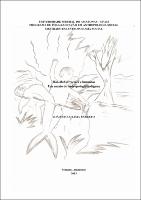| ???jsp.display-item.social.title??? |


|
Please use this identifier to cite or link to this item:
https://tede.ufam.edu.br/handle/tede/4629| ???metadata.dc.type???: | Dissertação |
| Title: | Wai-Mahsã: peixes e humanos. Um ensaio de Antropologia Indígena |
| ???metadata.dc.creator???: | Barreto, João Paulo Lima  |
| ???metadata.dc.contributor.advisor1???: | Santos, Gilton Mendes dos |
| First advisor-co: | Santos, Geraldo Mendes dos |
| ???metadata.dc.description.resumo???: | Esta dissertação constitui uma reflexão preliminar sobre o conhecimento Tukano da relação entre humano e não-humano para além de narrativas míticas. Seu foco está na diferenciação entre as categorias de wai-mahsã (humanos invisíveis) e wai (peixe). Os waímahsã são seres humanos que habitam nos domínios da terra, floresta, ar e água. Eles detêm a capacidade de metamorfose e camuflagem, assumindo (vestindo a roupa) a forma de animais e peixes e adquirindo suas características e habilidades físicas. São também a fonte de conhecimento, aqueles com os quais os especialistas tukano (yai, kumu e baya) devem se comunicar e aprender, acessando neles seus conhecimentos. A categoria de wai (peixe), ao contrário de algumas conclusões antropológicas, não possui atributos antropocêntricos, isto é, não tem status de gentes ou pessoas. Para os Tukano, os peixes nunca tiveram, nem mesmo em sua origem mítica, condição humana. Pelo contrário, como veremos, sua gênese está quase sempre relacionada ao que é descartado: restos de madeira, objetos e ornamentos abandonados pelos wai-mahsã, as partes descartadas e podres do corpo humano etc. Esta dissertação é ainda uma tentativa de desfazer a confusão feita entre os conceitos de wai-mahsã e wai. |
| Abstract: | This dissertation is a preliminary reflection on Tukanoan knowledge about the relationship between human and non human, beyond the mythic narratives. It is focused on the distinction between the categories of wai-mahsã (invisible humans) and wai (fish). The wai-mahsãare human beings dwelling the domains of earth, forest, air and water. They have got the faculty of metamorphosis and camouflage, assuming (dressing) the form of animals and fishes, and acquiring their traits and physical skills. They are also the source of knowledge: Tukanoan specialists (yai, kumu and baya) must communicate with them, and from them they get their knowledge. The category of wai (fish), unlike some anthropological conclusions, does not have anthropocentric attributes, in other words, it does not have the status of people. For Tukanoan, fishes never had a human condition, even in their mythic origin. Contrariwise, their genesis is often related to discarded things: wood debris, objects and ornaments dismissed by waimahsã, discarded and rotten parts of human body, etc. This dissertation is also an attempt to undo the misunderstanding between the concepts of wai-mahsã and wai. |
| Keywords: | Tukano Alto Rio Negro Relação humanos e não humanos Tukanoan High River Negro Relationships between human and non human |
| ???metadata.dc.subject.cnpq???: | CIÊNCIAS HUMANAS: ANTROPOLOGIA |
| Language: | por |
| ???metadata.dc.publisher.country???: | Brasil |
| Publisher: | Universidade Federal do Amazonas |
| ???metadata.dc.publisher.initials???: | UFAM |
| ???metadata.dc.publisher.department???: | Museu Amazônico |
| ???metadata.dc.publisher.program???: | Programa de Pós-graduação em Antropologia Social |
| Citation: | BARRETO, João Paulo Lima. Wai-Mahsã: peixes e humanos. Um ensaio de Antropologia Indígena. 2013. 93 f. Dissertação (Mestrado em Antropologia Social) - Universidade Federal do Amazonas, Manaus, 2013. |
| ???metadata.dc.rights???: | Acesso Aberto |
| URI: | http://tede.ufam.edu.br/handle/tede/4629 |
| Issue Date: | 2-Aug-2013 |
| Appears in Collections: | Mestrado em Antropologia Social |
Files in This Item:
| File | Description | Size | Format | |
|---|---|---|---|---|
| Dissertação - João Paulo Lima Barreto.pdf | Dissertação - João Paulo Lima Barreto | 3.25 MB | Adobe PDF |  Download/Open Preview |
Items in DSpace are protected by copyright, with all rights reserved, unless otherwise indicated.




